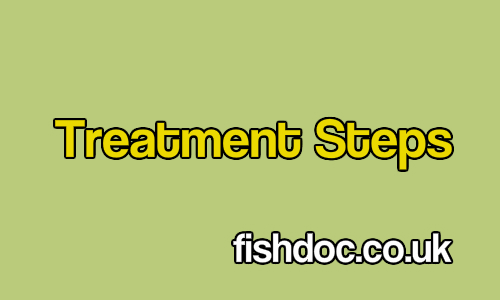When disease is suspected
Any unusual behaviour or changes in physical condition often indicate a health problem. As already stated, it is impossible to make a firm diagnosis based purely on ‘symptoms’ or clinical signs. However, careful observation of symptoms helps to reduce the number of possible causes. See clinical signs- a guide to common problems
Making a definitive diagnosis
For the most effective approach to health problems, we need to identify ALL existing conditions. For example a fish may have parasites as well as a bacterial infection, or there may be more than one species of parasites present. We also need to identify any underlying causes such as water quality or environmental stress. Unless these are resolved at the same time, treatments may be ineffective. See disease diagnosis– a guide to diagnosing fish disease
Other options to a proper diagnosis
In the majority of cases the simple procedures above will identify the problem. However, the reality is that few fish keepers have the facilities, equipment or experience to carry them out. This is a common problem, leading to complications and unnecessary losses. I would strongly urge all fish keepers to either get themselves equipped so that they can carry out basic ‘first aid’ or find someone who will assist them.
If, for what ever reason, it isn’t possible to have the fish properly examined, the following procedure may help. However, I should stress that this is a poor option and will obviously have a lower success rate.
- Carry out core water tests for ammonia, nitrite, pH and hardness. See Water Testing for more details. Monitor water quality on a regular basis.
- Give the system and filter a good clean in case there is decomposing organic matter polluting the water. See organic pollution
- Carry out a 25-50% water change to dilute any toxins or pollutants. Repeat again 7 days later.
- Examine the fish.Redness, heavy respiration, frayed fins, rubbing, flashing, and lethargy may indicate a parasite infection See the parasite page for more details about parasite disease. Please be aware that these symptoms can be caused by other problems. Use a course of [strong] proprietary anti-parasite treatment, preferably several treatments over a period of 10-days. Severely affected fish can also be given a salt bath every day for 2-3 days. See salt treatmentFish ‘breathing’ heavily and hanging under the water surface or near water returns may indicate gill disease. If possible try to examine the gills for signs of gill rot. Try treating with chloramine-T and QACs baths on alterative days over a 6 day period.
If the fish has open lesions, or fin rot, this may indicate a bacterial infection. See the bacterial infections pages for more details. It is probably worth carrying out steps 1-3 at the same time as any antibacterial treatments in case there is also a water quality or parasite problem.
A firm, unsymmetrical swelling of the abdomen, without raised scales or inflammation could indicate a tumour. This would require surgery
A soft, symmetrical swelling of the abdomen, with or without raised scales, could have several possible causes, but the only practical treatment would be to assume a bacterial infection. See antibiotics.
Growths on the skin or body, are usually benign. The only practical treatment would be surgical removal
Loss of equilibrium has many causes. See frequently asked questions.
Again, I stress that ‘blind treatments’ are a poor option to a proper diagnosis, but it is better than nothing. Obviously, while this procedure will help in many cases, it will not cure all problems. If there aren’t any signs of improvement within 7-10 days, it really is important to have the fish properly examined.

